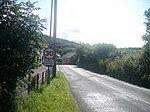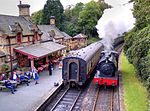Bouth
Colton, CumbriaCumbria geography stubsUse British English from September 2019Villages in Cumbria

Bouth is a village in the South Lakeland district of Cumbria, England. Historically, it was part of the county of Lancashire. It is within the Lake District National Park. The village's pub, the White Hart, was shown in the short-lived 1990 ITV sitcom Not with a Bang.
Excerpt from the Wikipedia article Bouth (License: CC BY-SA 3.0, Authors, Images).Bouth
Wear Bridge,
Geographical coordinates (GPS) Address Nearby Places Show on map
Geographical coordinates (GPS)
| Latitude | Longitude |
|---|---|
| N 54.261552 ° | E -3.032251 ° |
Address
Wear Bridge
LA12 8JB , Colton
England, United Kingdom
Open on Google Maps










